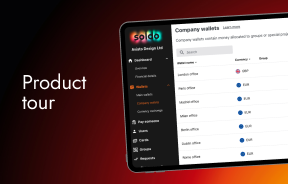Episode Summary
If you enjoy nerding out over numbers but also consider yourself a people person, Anders Liu-Lindberg, co-founder of the Business Partnering Institute, has a new finance job for your consideration: business partner.
“Unlike other roles in finance, business partnering is an interaction between people — whereas if you’re an Accountant or a Controller, you mostly interact with the numbers,” Anders says on this episode of The CFO Playbook.
Another incentive: more companies are hiring CFOs with business partnering experience instead of finance alone, because the skill set lends itself so well to a high-level role.
“You need to be able to influence decisions, communicate assertively, build relationships with people,” Anders says of both the business partner and CFO roles. “That’s how you build trust. If you’re not trusted, you cannot influence any decisions.”
Anders previously worked as the business partner for the Europe and Middle East region for Maesrk, the largest container-shipping company in the world. For him, the feeling that came from providing real support to stakeholders brought a rush totally separate from career advances.
“It gives you a high on adrenaline: it’s a fantastic feeling when you have these successful breakthroughs within business partnering,” he says. “I wish everyone could experience this rush of, ‘I was a great partner, I created value and I got great feedback from our stakeholders — this thing rocks!’”
Also in this episode: the power of a 30-minute lunch, and why good business partners don’t send reports.
Connect with Anders on LinkedIn.
Connect with our host Rob on LinkedIn.
Full show notes and resources from this episode can be found here.
If you want a better way to track and control your team’s spend, checkout Soldo.com.
Guest Analysis
Name: Anders Liu-Lindberg
What he does: Anders Liu-Lindberg is the Co-Founder, COO and CMO of the Business Partnering Institute, supporting business partners around the globe. He’s also the former Head of Global Finance PMO for Maersk, the world’s largest container-shipping line.
Key Quote: “Looking at business metrics brings the discussion forward to a time where you can take action. If you take action on financials, you’re always going to be too late. It’s not to say you can’t, just that you’re going to be too late and you will miss out on one or two months of interventions.”
Where to find Anders: LinkedIn | Twitter
From Anders’ Playbook
Impact = insights x influence.
A business partner’s job is to provide stakeholders with information that will help them make better-informed decisions. In other words, insights. But even the best researched and most valuable insight is useless if you can’t get anyone to first of all pay attention to it, and second of all, act on it. You need both to have an outsized impact.
When you’re ready to add business partnership, build it on a strong foundation.
Creating a business partnership component in your company requires a strong foundation. First, create a companywide definition of the business partner’s role. Establish what skills you expect a business partner to have. Determine the structure of the relationship between the business partner and stakeholders.
Decide what benefits you expect a business partner to deliver, and how you will measure their progress. Laying this groundwork is vital — if you’re not prepared to commit to it, wait until you are.
Go out of your way to get feedback on your performance.
For business partners, ensuring that you’re delivering real results for your stakeholders requires a lot of follow-up on your end and a little on theirs. Keep a record of the actions you’ve taken to help them achieve their goals: if it’s just writing reports, you’re not really contributing.
If anyone knows whether you’ve made a real difference to a department’s successes, it’s the stakeholders — so ask them. Send out a short survey once a quarter or so, asking for ratings and feedback. Follow it up with face-to-face meetings. This is especially important if you’re working with a new team, but it’s always good to let them know you take their opinions and constructive criticism seriously.
Episode Highlights
Think like a business partner every day
“Business partnering is first and foremost a mindset, and sometimes a role. It should be a mindset for everyone in the finance function to say, ‘Today I go to work to create value, to drive some new information that someone can use to make better decisions.’ So anyone can be a business partner.”
Prioritize the business metrics over the financials
“When driving performance management, don’t just talk about the financials: Talk about the business metrics. That’s what made me very successful in my last role. I said, ‘Let the financials be what the financials are, let’s just focus on the business metrics, because they are leading indicators for the financial metrics.’ If we do well on business metrics, the finances should take care of themselves.”
Good business partnering = asking questions, finding solutions
“Business partnering is the last mile that makes the rest of it count. We don’t have a robot yet that can sit next to us and we can ask all the questions we want and it will come up with the right answer. So business leaders need partners to advise on the best possible decision. It doesn’t mean that the business partner is always right. It could be they make a recommendation, someone else makes a recommendation, and they go with the other recommendation. But we are there to qualify the discussion around making the best possible decisions.”
Stop sending, start talking
“Never send out anything without following up with the receiver: ‘Is this useful? What actions should we drive with it? Let’s have a talk around that.’ If you only send emails, stop — go and have a conversation and figure out what’s useful. If stopping those 30 reports that you were sending out means you get a few angry emails back, that’s good: at least it shows that people were using them. But stop sending, start talking.”
See stakeholders as customers
“Think of yourself as a key account manager for a customer: How would you treat that customer? That’s how I want you to treat a business stakeholder. We want to find out the key pain point of the customer, and as a supplier, you want to help them alleviate those key pain points. It should work exactly the same way as a business partner.”
Business partnering makes finance work more meaningful
“We did a full day virtual training session some weeks back, and it was an awesome experience with an engaged team and engaged leader and great interactions with everyone. I left the office high on energy because it was such an amazing experience. I really think that for many finance professionals, business partnering is a way to get those experiences, because you are involved in everything that goes on in the business and you feel like you’re making a difference.”
Top quotes:
“Look at the stakeholders, the CEOs and CXOs of the world: They want this partner, they want someone to help them make better decisions. So it’s a demand coming from the business already. You’re starting to see more CFOs and senior finance leaders being let go because they are not business partners. Now, you’ve got to be this adviser and if you’re not, you won’t last long.”
“I use this simple approach, which I call surprise and deliver. You deliver a positive surprise, something the stakeholder did not expect from you, but can actually help them. And then of course you have to deliver on it.”
“We don’t have a robot yet that can sit next to us and we can ask all the questions we want and it will come up with the right answer. So business leaders need partners to advise on the best possible decision. … that is a key part of the future of finance — we are there at the table, not just reporting numbers, we’re contributing with business insights, making recommendations … about how to move the company forward, realize the strategy, create value. That’s the future of finance.”

















